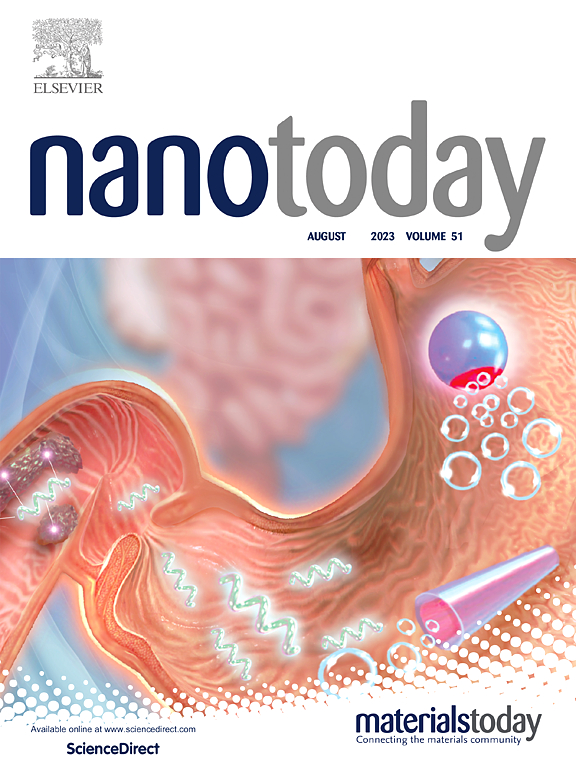DNA纳米水凝胶和Pb2 +特异性识别使一罐电化学外泌体适体传感器能够用于乳腺癌分期
IF 10.9
1区 材料科学
Q1 CHEMISTRY, MULTIDISCIPLINARY
引用次数: 0
摘要
在本研究中,开发了一种用于快速灵敏检测肿瘤来源外泌体的一罐电化学配体传感器。该策略使用了一种靶向性DNA纳米水凝胶,该凝胶整合了用于特定识别的适体,Pb2+作为信号输出元件。这种均相方法的关键创新之处在于它能够通过电化学分析区分游离Pb2+和g -四复体Pb2+配合物。上皮细胞粘附分子(Epithelial cell adhesion molecule, EpCAM)被选为乳腺癌源性外泌体的靶标。适配体与靶标的结合触发了DNA纳米水凝胶的解体,暴露出大量选择性结合Pb2+的g -四plex,从而放大了电化学信号并实现了敏感检测。此外,分析系统在45 min内完成,检出限(LOD)为300颗粒/mL。同时,将该策略应用于临床样本,可以准确区分乳腺癌患者(n = 40)和健康对照(n = 12),特异性、敏感性和准确性分别为91.7 %(11/12)、95 %(38/40)和96.2 %。此外,该方法在区分早期和晚期癌症方面表现出很强的能力,准确率为86.1% %。这些发现与影像学和病理结果非常一致。总之,这种基于外泌体的液体活检方法显示了增强乳腺癌诊断和分期的巨大潜力,为个性化治疗决策提供了有价值的支持。本文章由计算机程序翻译,如有差异,请以英文原文为准。
DNA nanohydrogel and Pb2 + -specific recognition enable one-pot electrochemical exosome aptasensor for staging of breast cancer
In this study, a one-pot electrochemical aptasensor was developed for the rapid and sensitive detection of tumor-derived exosomes. This strategy used a target-responsive DNA nanohydrogel that integrated an aptamer for specific recognition, with Pb2+ serving as the signal output element. The key innovation of this homogeneous method lied in its ability to distinguish between free Pb2+ and the G-quadruplex-Pb2+ complex through electrochemical analysis. Epithelial cell adhesion molecule (EpCAM) was selected as the target for breast cancer-derived exosomes. The binding of the aptamer to the target triggered the disintegration of the DNA nanohydrogel, exposing abundant G-quadruplexes that selectively bound to Pb2+, thereby amplifying the electrochemical signal and enabling sensitive detection. Additionally, the analysis system was completed within 45 min, with a limit of detection (LOD) of 300 particles/mL. Meanwhile, the application of this strategy to clinical samples enabled accurate differentiation between breast cancer patients (n = 40) and healthy controls (n = 12), achieving a specificity, sensitivity, and accuracy of 91.7 % (11/12), 95 % (38/40), and 96.2 %, respectively. Furthermore, this approach demonstrated strong capability in differentiating between early- and advanced-stage cancer with 86.1 % accuracy. These findings were in strong agreement with imaging and pathological results. Overall, this exosome-based liquid biopsy method demonstrates significant potential for enhancing breast cancer diagnosis and staging, providing valuable support for personalized treatment decisions.
求助全文
通过发布文献求助,成功后即可免费获取论文全文。
去求助
来源期刊

Nano Today
工程技术-材料科学:综合
CiteScore
21.50
自引率
3.40%
发文量
305
审稿时长
40 days
期刊介绍:
Nano Today is a journal dedicated to publishing influential and innovative work in the field of nanoscience and technology. It covers a wide range of subject areas including biomaterials, materials chemistry, materials science, chemistry, bioengineering, biochemistry, genetics and molecular biology, engineering, and nanotechnology. The journal considers articles that inform readers about the latest research, breakthroughs, and topical issues in these fields. It provides comprehensive coverage through a mixture of peer-reviewed articles, research news, and information on key developments. Nano Today is abstracted and indexed in Science Citation Index, Ei Compendex, Embase, Scopus, and INSPEC.
 求助内容:
求助内容: 应助结果提醒方式:
应助结果提醒方式:


